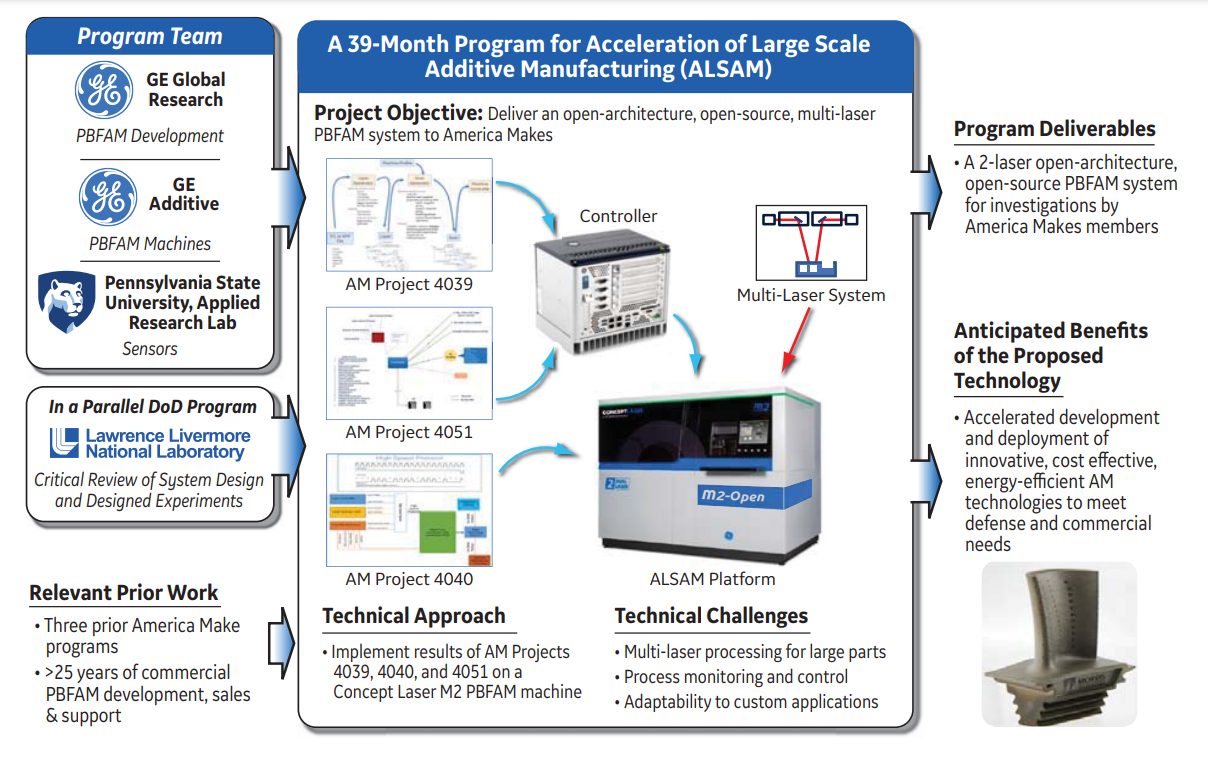


Overview of the ALSAM project approach integrating and further building upon America Makes Projects 4039, 4051, and 4040 in commissioning an enduring research asset for AFRL, DoD, and academic community at large.
Problem
Laser Powder Bed Fusion (LPBF) offers many advances in design flexibility consistent with requirements for future mission-critical systems. Existing domestic research capabilities afforded through private partnerships with OEMs did not afford sufficient control of next-generation materials. Several Mission Critical refractory alloys require precise control of both the heating and cooling rate beyond what has been practical using existing LPBF equipment and only possible for an open architecture multi-laser platform. The existence of this platform will allow the Department of Defense (DoD) and our domestic research partners the ability to further advance manufacturing research in support of materials meant for the most austere conditions.
Objective
The objective of this project was to generate an open architecture multi-laser system with sufficient control and monitoring to chart a path forward to new manufacturing capabilities domestically for LPBF systems and mission-critical alloys. The system was intended to permit further research in increased productivity, increased part size, process quality and integrity, and necessary thermal gradient control to allow ease of manufacture of challenging refractory alloys. In addition, the team sought to commission and embed this worldclass, unique research asset at AFRL for future utilization by the DoD, industry, and academia. This asset was uniquely suited to address critical challenges which hinder the development of hot structures and the needs of other mission-critical technologies identified by the Office of the Secretary of Defense (OSD).
Technical Approach
The project team included the Additive Manufacturing Laboratory at GE Global Research (GEGR), the Applied Research Laboratory at the Pennsylvania State University (Penn State), and GE Additive. After a critical design review of the machine and the expected open-architecture modifications, the team modified a GE Concept Laser M2 by replacing the controller and control software with those developed under America Makes Programs 4051 and 4039. In addition, the multi-spectral sensor developed by Penn State under America Makes Program 4040 was improved for down-beam sensing for installation on each of the lasers of the ALSAM Platform. Everything from the system architecture to the path planning and control software was opensource and customizable to meet the research needs set forth by the DoD. The unique system performance and calibration of the novel open architecture multi-laser system were validated through experimentation in partnership with Lawrence Livermore National Laboratory. The asset developed was transitioned to a secure facility at AFRL Dayton where personnel was trained to operate and modify the system to meet future research and mission needs related to refractory alloys, manufacturing of hot structures, and critical components of highspeed systems. Domestic OEMs and research institutes were made aware of this unique research capability so they could partner with AFRL to address alloy and process development needs for challenging materials.
Accomplishments
The key deliverable of this project was an open-architecture multi-laser platform for research on production efficiency and scalability for the identification of best practices for scan speed, hatch spacing, power, and stitching, among numerous other process parameters. The platform was used to facilitate the study for challenging alloys consistent with those demanded by high-temperature and pressure-austere environments. The ALSAM Platform is a flexible resource in that it is controlled with opensource software for both scan path generation and machine control. This allows, for example, tailored thermal management experiments, which are useful for difficult-to-weld alloys. The project falls within the Process Temperature Gradient Control of the Critical Technology element of the Process Swimlane of the Technology Roadmaps. Thermal gradients were achieved with this machine on two geometric scales: the length of the build height (using the heated build plate) and the length of the weld pool (using multiple lasers in a “follow-me” post-weld heating concept.) The advanced multi-spectral sensor of Penn State’s Program 4040 included “down-beam” sensing capabilities on each laser of the new system for process monitoring and an analytic was generated for processing results.
Deploying the ALSAM Platform to AFRL under this program demonstrated the technology in a production-representative environment, advancing the Readiness Level of the open system to MRL7. The availability of the open machine enabled subsequent research programs aimed at achieving MRL8 by identifying specific process parameters, multi-laser strategies, feedback strategies and sensors to be validated prior to moving to a pilot line. The availability of this system stationed at a controlled site enables sensitive research to be conducted in a timely manner where previously no research asset existed in the continental United States that could be used to address these specific concerns for refractory alloys critical to the success of highspeed systems.
Project Participants
Project Principal

Other Project Participants
- Pennsylvania State University Applied Research Laboratory
Public Participants
- U.S. Department of Defense
